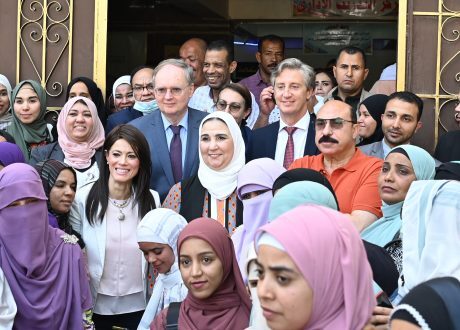
Egypt, UNDP, EU working together to promote sustainable development in Aswan
Egypt’s Ministry of Social Solidarity, the United Nations Development Program (UNDP) and the European Union ...

The World Bank spends about $ 5 trillion annually to contain air pollution, with most of the damage in the developing world. Air pollution is a major global health hazard that affects almost everybody alive today, and kills seven million people a year.
Low and middle-income countries bear the brunt of pollution, but nobody is safe; air pollution knows no borders.
Nine out of 10 people are breathing air that the World Health Organization (WHO) says is unsafe—that’s more than 6.76 billion people.
Carbon monoxide, carbon dioxide, nitrogen dioxide, particulate matter, sulphur dioxide, hydrocarbons and lead—all are literally taking breath from our bodies. And even when it doesn’t kill, air pollution shortens the average life by one year.
Invisible airborne particles known as particulates are the most dangerous. They can be made of soot, sulphates, lead or black carbon. And the tinier they are, the deadlier. Microscopic particulates with a diameter of less than 2.5 micrometers (PM2.5) are absorbed directly into the brain, lungs and bloodstream, causing lung cancer, strokes, heart disease and diabetes.
Air pollution can also lower people’s IQ and increase the risk of dementia and miscarriage. And it’s a leading cause of asthma in children. A new Lancet study estimates that four million children develop asthma every year—that’s 11,000 new cases every day.
The industrial lifestyle is the source of most ambient pollution. Poisonous chemicals are produced from petrol or diesel-powered vehicles or coal burning to generate.
Chemical, mining and agricultural industries also produce air pollution, as do landfills. Fires, deforestation, changing weather patterns and natural phenomena such as sandstorms and volcanic eruptions are also contributing to poor air quality in some places.
Poor air quality also damages vegetation and crops, reduces biodiversity, strips soil of its nutrients, speeding up corrosion and generally adding to the greenhouse effect.
According to WHO’s Global Ambient Air Quality Database 97 percent of cities in low and middle income countries don’t meet safe standards. In high income countries, about half of all cities of more than 100,000 people have unsafe air. In the most polluted countries pollution is responsible for more than one death in four.
Fourteen of the world’s 15 most polluted cities are in India, but most African cities also don’t meet minimum air quality standards. Kampala, Uganda’s capital, and Bamenda in Cameroon measured more than ten times the recommended WHO level for air quality, while cities in Mauritius, Nigeria and South Africa were six times higher.
The Sustainable Development Goals (SDGs) of the 2030 Agenda call for substantially reducing the number of deaths and illnesses from air pollution. SDG 11 – Sustainable cities and communities – recognizes the number of challenges associated with rapid urbanization and the factors that make city dwellers uniquely vulnerable to pollution-related disease.
UNDP works with partners and countries across the world to build sustainable and healthy futures for everybody.
Poorer communities have too often not had the benefit of technology and regulations that have successful track records elsewhere. It’s time to build new partnerships with the public sector and ensure that citizens have the information to hold their governments accountable.
Cleaner air, better health, longer lives, money saved; tackling air pollution will provide real benefits for the planet. It will provide impetus for several of the SDGs and spur a transition to a clean, sustainable future that leaves nobody behind.
Egypt’s Ministry of Social Solidarity, the United Nations Development Program (UNDP) and the European Union ...
Saudi Arabia and the United Nations Environment Program (UNEP) have launched campaigns to combat desertification, ...
Cairo Festival City Mall (CFC), owned and operated by Al Futtaim Group, announced continued partnership ...


اترك تعليقا